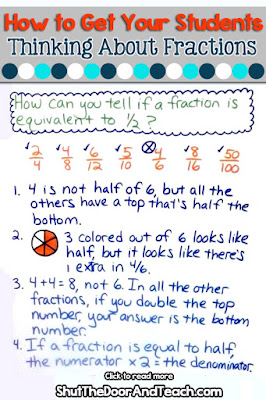After all the talk about 1/2, and making fractions that were
equivalent, I wanted my fourth graders to do some fraction stations.
It was the Monday after February vacation,
and I was really looking forward to trying this out!
I set up:
- Fraction Circles
- Fraction Bars
- Fraction Strips
- Pattern Blocks
- and my Trading Fractions activity game, which I led with
each group that rotated through.

I had the kids write down the fractions they found on an
index card.
I let them know I was
looking forward to posting their attempts on our classroom blog.
I also told them to write "one wrong
fraction" which the kids who sat at their table next would need to find,
and cross out.
Unfortunately, the stars did not align today. I imagined this was going to be a fun,
engaging activity, but the kids had other ideas. They were not...shall we say...in the mood
for group work. Even though they each
had their own set and didn't have to share!
I just had to shut it down and redirect.
I gave them a fairly basic assignment for homework: draw 3 fractions that are equivalent to
1/2. Non-threatening and short, even if
they weren't all going to master it yet.
That night I changed my math (and science game) plans for
the next day. Some needed more practice
finding equivalent fractions for 1/2, and some were ready for a challenge. So I created a worksheet (I know, this is a
dirty word in education nowadays) and a coloring one at that.

It was a SMASH HIT.
Although I love group work, and I believe that working cooperatively is a skill my students need to learn, sometimes it's too much for them to practice the social skills and the academic concept at the same time. And when that's the case, it's not the best way for them to learn the academic concept. I have so many
strong personalities in my class this year that they butt heads a LOT. As a result, they often crave a break from,
well, each other.

The
coloring page (it's a freebie in my store) allowed them to each hone in on their own
paper, enjoy the relaxation that coloring brings, and go at their own
pace.
I pulled those few kids who still
needed manipulatives to work with me, and all but one weaned themselves off
before they were done.
See, I started out this lesson telling them to memorize ONE
of their fractions. They came to the
rug, and I gave them each 2 Post It notes.
I told them, "I want you to write the fraction you memorized on one
note. Then, I want you to write a WRONG
fraction on the other. Try to trick
me. When you finish, stick them both up on the
board in random spots, and I'll sort them out.
Basically...you're quizzing ME this time."
So I did, it was easy enough to do this rapidly, even when I
told a couple of my higher level thinkers "Go on, do just one more and
make it REALLY difficult for me."
I told them that once I finished (to finish I went through each fraction, telling the person who wrote it to call out yes or no as I pointed to theirs, to quickly verify that I got them all right) I was going to ask them to
guess how I did it (we do "turn and talk with a partner" a lot in my
room). And the conversations that
resulted were AWESOME. At first I heard:
1. She memorized
them.
2. No, she couldn't
have memorized all those.
3. Maybe she is
imagining what they look like.

Then I started to hear them "getting it."
They started talking about numbers being half
of each other.
They started to talk
about multiplying by 2 or dividing by two.
They were noticing there were a lot of even numbers.
They were using the word
"double."
They were drawing
fractions to show each other why fractions were "wrong" or "right."
It was truly a beautiful thing.
I commemorated their brilliance (and redemption, ha!) on an
anchor chart. I called on kids to
explain why fractions are, or are not, equal to a half. And just for today, on their coloring sheet,
I told them, "Just color the fractions that equal a half green. Don't worry about the other directions about
less than and greater then being yellow and orange; we'll do that
tomorrow."
Of course my higher level kids begged me to "let them" do it today,
haha.
I "allowed" them to
write "O" and "G" in pencil, so that if they decided tomorrow that they made a
mistake it would be fixable.
But they
were already getting it, so I knew I was ready to start really differentiating
my fractions instruction tomorrow.
Already today I did so by telling them to just copy ONE of the 4 methods
for determining if a fraction is equivalent to 1/2.
I think I like that method a lot better than
having every kid write every thing.
I'm
going to try to do more of this in the future!

Next week I'll show you another anchor chart we created that's all about relating fractions to the "benchmark" fraction of 1/2, and another sorting lesson that inspired more great student-led discussions. This lesson was a turning point, but not an ending when it comes to my fractions unit!
 As you can see, we use the ANSWER method to for written responses to reading. The ARMS and CUPS acronyms have been courtesy of Pinterest (those links will bring you to those fantastic anchor charts). And DYB means to "Do Your Best!"
As you can see, we use the ANSWER method to for written responses to reading. The ARMS and CUPS acronyms have been courtesy of Pinterest (those links will bring you to those fantastic anchor charts). And DYB means to "Do Your Best!" 
















.jpg)











